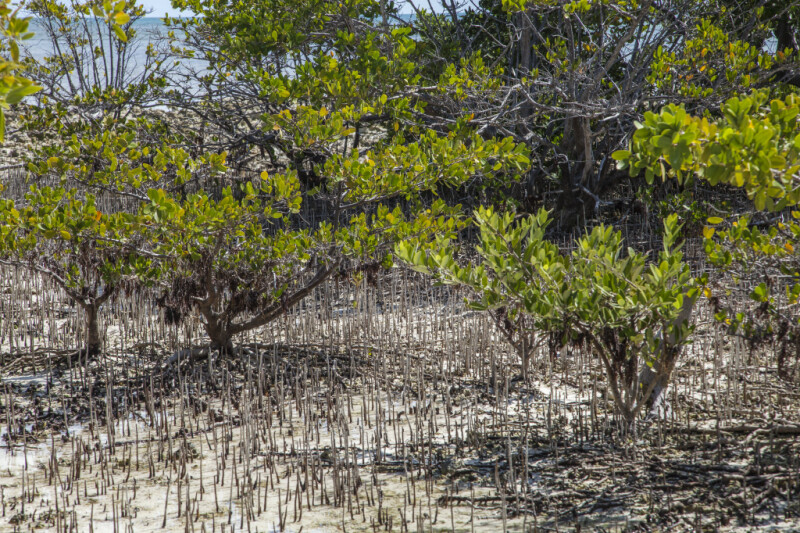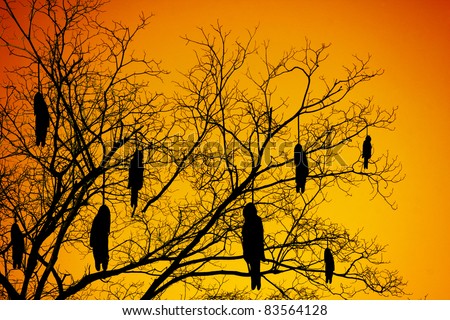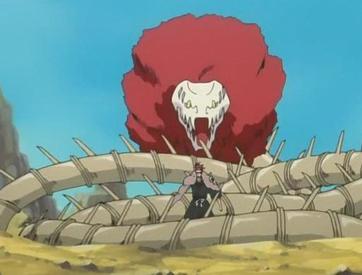Carrion Mangrove
 No. Enc.:
No. Enc.: 1 (1d4)
Alignment: Neutral
Movement: None
Armor Class: 3
Hit Dice: 12
Attacks: see below
Damage: see below
Save: L6
Morale: None
Hoard Class: XIX (x2)
XP: 2000
Carrion Mangroves are immobile, mutated Avicennia germinans which appear among, and nearly identical to their unmutated versions. Appearing as a 40'-60' tall mangrove tree with dark brown bark, elliptical, dark green leaves, and small creamy white flowers, their distinguishing feature is their long, underground system of roots and hundreds of pencil-like pneumatophores which grow upwards from the roots, appearing as a field of stakes. Decaying corpses may be noticed among the root system on a roll of 1-3 on 1d6.
This mutant tree doesn't actively hunt, but rather depends on its root system to deal with prey. Each Carrion Mangrove's root system covers a 100' diameter area around the tree. When prey is detected through ground vibrations, the nearest pneumatophores (roll 2D10 to determine number) shoot small poisonous thorns straight up into the prey doing 1d4 damage each. Each thorn has a Class 11 poison which causes paralysis for 2d6 rounds for each thorn which strikes the target. Victims that are paralyzed tend to fall directly onto 2d4 pneumatophores, causing 1d6 damage for each one struck, additionally, each pneumatophore pumps out the same Class 11 poison each round. Since these victims generally can't save against so many poison sources, they tend to be paralyzed until death from thirst or drowning. Carrion Mangroves feed on the blood and decaying bodies thus created.
These trees can be found just above the high tide line in the sandy or muddy regions around brackish water estuaries, lagoons, and mangrove swamps.
Mutations: Modified Vines and Roots (CotTW)
Hangman's Tree
 No. Enc.:
No. Enc.: 1 (0)
Alignment: Chaotic
Movement: None
Armor Class: 3
Hit Dice: 9
Attacks: 4 (constrictive tendrils)
Damage: 2d6
Save: L5
Morale: None
Hoard Class: XIX
XP: 1700
This tree is a mutated version of Carya texana appearing as a hickory tree 20-30' tall with dark grey bark covering a trunk roughly one foot in diameter, shiny, dark green leaves which turn golden-yellow in autumn, bronze-colored nuts, and yellow catkins.
Hangman's Trees attack by dropping 1d4 constrictive tendrils around prey. A successful attack roll achieves constriction, and the victim will suffer 2d6 damage on each consecutive round. The length of these tendrils ranges from 10’ to 20’.
They are typically found in hilly, forested regions. Their fruit is edible and considered tasty (see
New Mutation - Edible Leaves)
Mutations: Prehensile Tendrils, Edible Fruit
Hellions
 No. Enc.:
No. Enc.: 0 (2d10)
Alignment: Neutral
Movement: None
Armor Class: 7
Hit Dice: 4
Attacks: 1
Damage: 4d6
Save: L2
Morale: None
Hoard Class: None
XP: 290
Hellions are mutant Helianthus annuus (sunflowers) that were failed bio-correcting solar collection plants, reflecting powerful beams of sunlight against nearby terrain as they track the sun across the sky. They appear as typical 10' tall sunflowers whose flowers actually track the sun's path across the sky. At frequent intervals (once every three rounds) during sunny days, they emit their stored solar energy at a spot up to 50' away. Often this results in only scorched ground, and the areas around Hellion fields are often scorched of vegetation making them easy to recognize. If any creature wanders into the area however, there is a chance that they may be struck by a beam (roll to attack any targets in the area with a -2 to the attack roll).
Mutations: Glow in the Dark (CoTW), Reflective Epidermis (Heat), Reflective Epidermis (Radiations), Thermal Emissions (Heat)







